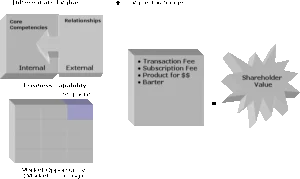"Business model" has to be the king of buzzwords. "Strategy" is not far behind but there is something about business models that makes it more powerful! This article tries to demystify the term.
A business model is the framework through which an organization creates sustainable value.
A business model is a framework or formula dependent on two variables, namely, differentiated value and value Exchange
The basic premise behind organizations is that they exist to create value for their stakeholders. The measure or metric of this value created depends on the organization in question. For example, value is measured in dollars and cents for profit organizations. Not for profit organizations measure the value they create in other terms such as people served or eradication of a disease etc.
This value must be sustainable in order for the organization to be successful over the long term or in other words a “viable” entity. One hit wonders are good if the hit is a big one. However, viable organizations are successful over the long term. Consequently, a business model’s main objective is to create viable organizations that deliver value in perpetuity.
Sustainability depends if the value is based on a “differentiated” business model i.e. the organization has a unique “formula” for success that cannot be copied easily or quickly. Another way of thinking about differentiated business models is to think of them as unregistered patents.
- Just like Coke’s formula is its very own forever, Dell’s unregistered “direct to customer; made to order” business model created unprecedented value for its shareholders for over a decade.
- Just like Coke changes its drinks and introduces new ones, Dell has had to change its business model to adapt to changing market conditions
Sustainability is not forever. Market conditions or pesky competitors will eventually force a company to change its business model. These model life cycles are shrinking but still last a few decades.
Differentiated value is created through two things:
- Business Capability
- Market Opportunity
Core competencies are what an organization does best - whether it has cutting edge technology or brilliant employees or efficient processes. This is the internal strength of the organization that gets it into the “business” and makes it viable over the long term. Its hard to duplicate and hence provides a barrier to entry for its competitors.
Business relationships are an equally important aspect of business capability. In the simplest form, they can comprise of binding long term contracts that prevent others from competing with them. For example, if a distributor has an exclusive contract for a given territory for 15 years, its competitors cannot market that product in that territory for that period. However, increasingly business relationships are much more than binding contracts. We live in an increasingly networked world and businesses must have a network to create value these days. The Japanese have the concept of a “Keiretsu” that exemplifies this concept of business relationships.
Market Opportunity
Market opportunity is what organizations leverage to get into business or stay there.
The most pronounced examples of this concept are when some killer product is introduced in a virgin market segment – often called the “first mover” advantage. The iPod shook up the media world. Napster shook up media companies. eBay, Amazon, Google etc. are all examples of organizations created on “white space” in their respective areas.
However, market opportunity more than having a first mover advantage. It is all about segmentation and innovation. The latter adapts existing products to suit a new need.
More importantly, as many first movers have realized, it takes a lot to create a market. Sometimes, more than what they have and hence many first movers perish creating a market that others then harvest. Remember Webvan?
Business capability and market opportunity result in value creation. However, this value can be maximized through the proper “value exchange’ mechanism.
Ever wonder, why car companies offer 0% financing? By manufacturing cars, they have created differentiated value that will sit on their lots without an appropriate mechanism for value exchange. In other words, if they only offered cars in exchange for cash, they would fold. By creating a mechanism for customers to “afford” these cars they unlock the value sitting on their lots and move it into their General Ledger – the only place where it really matters!
The concept of value exchange is intertwined with the concept of pricing and product bundling or ‘offering”.
This concept also is critical for value sustainability. “Product for cash” can create instantaneous value. However, “barter” can create substantially more and sustainable value than a cash transaction. Often, businesses are short sighted and forget this.
A business model is the anchor for IT Strategy
In an associated article, we will discuss how the concept of business model is critical to IT Strategy.


